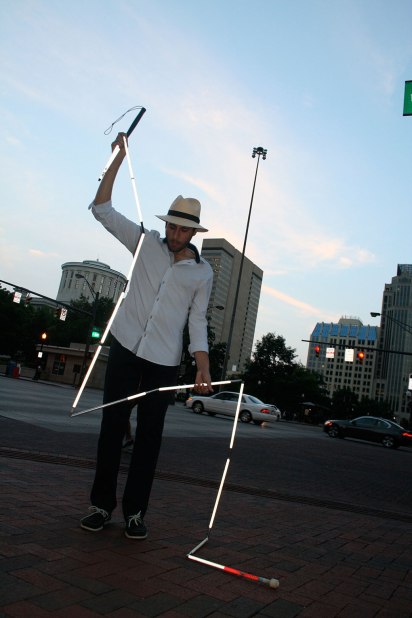
“Papalia’s work, which takes the form of participatory public projects, explores the topic of access as it relates to public space, the Art institution, and visual culture—as the artist’s own access is defined by a visual impairment. Papalia invites the participant to explore the possibilities for learning and knowing that become available through the non-visual senses, and to trust in the revelatory practice that is non-visual interpretation. Through exercises in trust and blind orienteering, participants discover new geographic contours from which to develop a sense of place. They begin to consider looking as one of the many ways to engage with and interpret their surroundings.”
Artist’s Statement:
You are closing your eyes. You have just entered the vast and vibrant dimension that is non-visual space. You put your hand on the shoulder of the person in front of you, and you lend your support to anyone who might want to join in this experience. You notice the pace of your breathing, you notice some sweat on your palms. As your focus shifts away from what is visual, the acoustic environment crashes around you. It consumes you like a tidal wave. With each event your sense of spatial scale shifts, and shifts again. A tight corridor, a field, of color. A wave of traffic. Your footsteps. You focus on the sound. You feel secure in knowing that you can rely on the person in front of you, and you begin to relax. You ease into your gait. You notice the pace of your breathing. You begin to trust in this practice.

—Reflection upon experiencing the Blind Field Shuttle, 2013
“I design experiences that allow those involved to expand their perceptual mobility and claim access to public and institutional spaces. Often requiring trust and closeness, these engagements disorient the participant while introducing new modes of orientation that allow for perceptual and sensorial discovery. Each walking tour, workshop, collaborative performance, public intervention, museum project and art object that I produce is a temporary system of access—a gesture that contributes to a productive understanding of accessibility. As an open-sourcing of my own access, my work makes visible the opportunities for learning and knowing that become available through the non-visual senses. It is a chance to unlearn looking and to take ones first few steps into a non-visual world.”
Text excerpts from the CUE Art Foundation
Short documentary film by Mickey Fisher on a social practice art project at Grand Central Art Center in Santa Ana, CA. Artist Carmen Papalia began using a white cane when his vision became impaired nearly ten years ago. For one day, he replaces his cane with a marching band.

